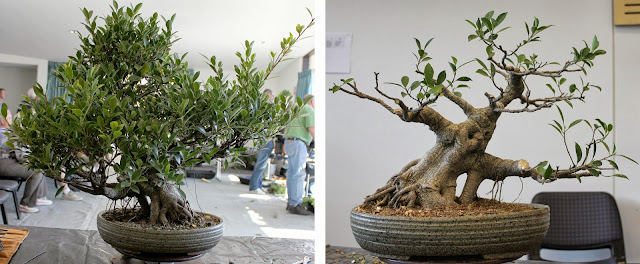At the beginning of this month, I attended this year’s “Tops Weekend” (Weekend Workshops at Stanwell Tops organised by the Illawarra Bonsai Society). The main demonstrator this year was Robert Steven, a bonsai artist from Indonesia known internationally for his two books. He practices bonsai at his bonsai centre in Jakarta. I was there just for a day and saw his two workshops and a demonstration. Images below show some of the trees from the workshops. Images on the left depict each tree before the workshop and images on the right show them after the workshop.
During the workshops Robert kept on emphasising that ‘bonsai rules’ are only guidelines designed for beginners. Once you understand the rationale behind the rules, you should follow the rationale and not necessarily the rules. As an example he drew two trees. One was a typical bonsai while the other was a tree with the first branch very short and growing at mid-height of the tree (not 1/3). The lengths of other branches of this tree were drawn at random as well. To my surprise the tree that didn’t follow classic bonsai rules looked more interesting and natural.
Another interesting observation Robert made is that bonsai represent trees seen from close distance rather than from far away. This is why bonsai with the first branch located relatively high on the trunk are preserved by us as taller trees. To fit the look of a tree viewed from close quarters bonsai must have a sufficient amount of detail. Features such as irregularly shaped foliage pads can provide that level of detail.
He said that one of the common mistakes made by many bonsai practitioners is shaping the canopy of a deciduous or a tropical tree as if it is a conifer in a triangular shape. Bonsai design must always take into account natural growth habits of a species. That way the bonsai will look genuine and will tell a story of its native habitat.
Robert reminded the participants to turn defects into features, but at the same time warned not have too many features: “The more you show, the less people see”.
He also pointed out the importance of negative spaces and ‘in-and-out’ spaces in the tree canopy. They make trees look more natural. Robert stressed that asymmetric balance is a very important concept in bonsai design. However, group plantings must have a focal point as well as asymmetric balance in overall composition.
Another thing I liked about Robert was that he was full of curious facts. Botanical terminology, plant anatomy, etymology of bonsai terms, etc. He said that he comes by such facts while doing research for his books.
In the evening, Robert did a demonstration. He decided not to do another conifer demonstration, which would produce an ‘instant bonsai’. Instead, he asked the audience to choose a couple of deciduous trees from a small batch of advanced bonsai stock. The first choice was the messiest tree in the batch with a seemingly confusing multitude of trunks (image 1 below). After a preliminary pruning of branches and roots, the number and shape of the trunks became more apparent. The position of the trunks in relation to each other was somewhat symmetrical (image 2 below). To overcome this, Robert changed the angle of the tree (image 3 below). This was followed by the removal of all unnecessary branches, which made the tree look unimpressive (image 4 below). For a finishing touch, however, Robert had a very impressive trick. He pulled out a bunch of artificial brunches made of wire and stated attaching them to the trunks to simulate the future development of the tree. The effect was very convincing indeed (image 5 below). The demonstration was quite entertaining.
The second tree chosen by the audience had a single trunk (image 1 below) and the demonstration involved a gradual removal of branches (image 2 below) with the final result shown in the image 3 below. This demonstration was more simple and straightforward.
As a whole, it was a fun day.











No comments:
Post a Comment